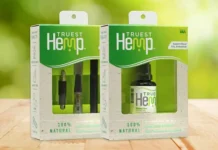Submitted by Two Sides
Paper-based packaging is made with a renewable natural resource – trees grown in sustainably managed forests – and when well-designed, efficiently manufactured, appropriately used and recycled at the end of its useful life, provides a host of benefits for people and the planet.
The strength and durability of paper-based packaging powers global commerce by ensuring the safe and efficient transport of goods, and its versatility and visual appeal help businesses effectively market their products. It communicates vital information to consumers, and provides the tactile pleasure that comes with receiving a special delivery or opening a gift. And importantly, when paper-based packaging is recycled it extends the life of the natural resources used to produce it and prevents waste from going to landfills. The paper and wood products industry is inherently circular in its supply chain, from the regeneration of renewable resources (trees) that supply fiber to recycling packaging and paper that is recovered and turned into new products. The industry manufactures more with less by efficiently using wood fiber, reusing water and pulping chemicals multiple times, utilizing manufacturing residuals and byproducts to produce carbon-neutral biomass energy and optimizing the use of nonrenewable resources.2
The forest products sector is central to the ongoing transition to a low-carbon and circular future rooted in renewable natural resources, also known as the bioeconomy. With their ability to capture and store carbon, fiber-based materials feed into a broad array of renewable solutions that can substitute non-renewable and fossil-based materials in products we use every day.3 Paper and paperboard packaging – which includes corrugated cardboard boxes, folding cartons, rigid paperboard boxes, flexible packaging, sacks and bags – is often the preferred sustainable packaging choice of consumers.5 Its key raw material, wood fiber, is a renewable resource and it’s also the most recycled of all types of packaging materials.6
Paper-based packaging is recycled more than any other packaging material
The benefits of recycling paper-based packaging include extending the supply of a valuable natural resource (wood fiber), saving landfill space, avoiding greenhouse gas emissions of methane released when paper decomposes in landfills and reducing the amount of energy needed to produce some paper products.
Nearly 81% of all paper-based packaging in the US is recovered for recycling, and more than 96% of corrugated (cardboard) boxes are recycled. Only 14% of US plastic packaging is recycled.6 In Canada, the national recovery rate of old corrugated boxes for recycling is an estimated 85%, with at least one provincial recycling program reaching 98%.7 Corrugated box fibers are recycled 7-10 times to make new boxes and other paper products.8 Around 90% of folding cartons (by the ton) in North America sent to the frozen foods sector are made of recyclable paperboard, and are easily recyclable in the normal waste stream.10 In addition to being recyclable, paper and cardboard packaging is made with recycled fiber. In the US for example, the average corrugated box is made with 50% recycled content, and nearly all old corrugated containers are used to make new paper products.11 In Canada, corrugated boxes and boxboard used for products like cereal and shoe boxes are mostly 100% recycled content.12 Nearly all Americans13 and Canadians14 have access to community curbside and/or drop-off recycling programs for paper and paper-based packaging.
Paper-based packaging protects more resources than it consumes
Paper-based packaging is a versatile, cost-efficient and safe method to transport, protect and preserve a wide array of items. It is engineered to be sturdy, yet lightweight, and is customizable to meet product- or customer-specific needs.
Packaging plays a critical role in protecting products and resources, and often helps reduce and prevent waste—especially when it comes to food.17 On average, packaging makes up only 10% of a food product’s energy footprint. In contrast, the food itself accounts for about 50% of the product’s energy footprint. So, protecting that food through packaging means keeping a big part of its footprint in check.17 Cities exist with the help of packaging. Most of the food and other goods they require are grown and produced outside of urban centers.17 In 2019, 271 million Americans lived in urban areas; 31 million Canadians lived in urban areas.18 Corrugated packaging can be a critical supply-chain efficiency tool for cost-effective product protection from products’ points of origin to their points of purchase and end-use.19 When the results of the available field surveys are compared to the acceptable limit for microbial loads on corrugated containers versus reusable plastic containers (RPC) for fresh produce, 100% of corrugated containers met acceptable sanitation standards while percentages as low as 50% of RPCs evaluated did not meet these same standards.20
The Recycled Paperboard Technical Association (RPTA) has developed a comprehensive program of testing and management systems, and uses a rigorous auditing process conducted by NSF International to assure brand owners that paper-based packaging products produced at North American RPTA-member mills are suitably pure for direct food contact packaging applications and meet all US Food and Drug Administration regulatory requirements that apply to recycled paperboard and corrugated board use in food packaging.21
Paper-based packaging supports healthy forests in North America
Sustainable forest management protects one of earth’s most important resources and ensures the long-term ability of the global forest products industry to meet society’s growing needs.
The use of wood fiber from sustainably managed forests promotes responsible long-term forest growth, so successfully in fact, that US forest area expanded an average of approximately 605,000 acres per year between 1990 and 2020.22 Canada’s forested area has remained quite stable for the past 25 years at approximately 857 million acres.23 In 2019, 52% of the forest area in North America was certified to an independent, sustainable forest management standard (Sustainable Forestry Initiative® (SFI®), Forest Stewardship Council® (FSC®), Programme for the Endorsement of Forest Certification (PEFC), the highest percentage of certified forestland anywhere in the world.22
The production of paper-based packaging does not result in deforestation. Deforestation is defined as the conversion of forest to other land use independently, whether human-induced or not. The term specifically excludes areas where trees have been removed as a result of harvesting or logging, and where the forest is expected to regenerate naturally or with the aid of silvicultural measures.22
The biggest threat to forests in the US is urbanization, but this threat can be mitigated by healthy markets for forest products, especially for products from highly productive working forests. Between 1982 and 2012, urban development was responsible for almost half (49.2% or 17.7 million acres) of all forestland that was converted to other uses in the United States.25
The conversion of forest to agricultural land is decreasing but remains the largest contributor to deforestation in Canada. Harvesting, forest fires and insect infestations do not constitute deforestation since the affected areas will grow back. According to laws, regulations and policies in place across Canada, all areas harvested on public land must be reforested, either by replanting or through natural regeneration. About 94% of Canada’s forests are on public land.26
Paper-based packaging helps tackle climate change
 There are three ways to mitigate climate change: by avoiding greenhouse gas (GHG) emissions, by storing GHGs (carbon) in forests and forest-based products, and by capturing GHGs from the atmosphere. The manufacture, use and recycling of paper-based packaging contributes to all three.
There are three ways to mitigate climate change: by avoiding greenhouse gas (GHG) emissions, by storing GHGs (carbon) in forests and forest-based products, and by capturing GHGs from the atmosphere. The manufacture, use and recycling of paper-based packaging contributes to all three.
Sustainable forestry practices increase the ability of forests to capture and sequester atmospheric carbon while enhancing other ecosystem services, such as improved soil and water quality. Planting new trees and improving forest health through thinning and prescribed burning are some of the ways to increase forest carbon in the long run. Harvesting and regenerating forests can also result in net carbon sequestration in wood products and new forest growth.27
The forest products industry plays an important role in contributing to the production of renewable energy and reducing dependence on fossil fuel by using residuals and byproducts (biomass) to produce much of the energy required for its operations. Because trees absorb CO2 when they grow, the international carbon accounting principle accepts that biomass is carbon neutral when combusted for energy.29
The US paper and forest products industry reduced carbon emissions by 23.3% between 2005 and 2018. The Canadian paper and forest products industry reduced its greenhouse gas emissions by 38% between 2006 and 2016.2,30
The recycling of paper-based packaging avoids greenhouse gas emissions that result when paper products are landfilled. At about 44.2 million tons, paper and paperboard recycling in the U.S. resulted in a reduction of about 148 million tons of carbon dioxide equivalents (CO2e) in 2017. This reduction is equivalent to removing over 31 million cars from the road for one year.31
Nearly every piece of plastic begins as a fossil fuel, and greenhouse gases are emitted at each stage of the plastic lifecycle: 1) fossil fuel extraction and transport, 2) plastic refining and manufacture, 3) managing plastic waste, and 4) plastic’s ongoing impact once it reaches our oceans, waterways and landscape.32
Paper-based packaging is practical, beneficial and appealing
Paper and cardboard are versatile and effective packaging materials, whether for storage or in transit, displayed in-store or used in the home.
Corrugated cardboard boxes are the backbone of the American supply chain. Some 38 billion packages are delivered safely in corrugated cardboard boxes each year. Corrugated packaging is frequently lightweight and can reduce shipping costs.33
Most Americans (83%) agree that paper and cardboard packaging can be innovative. In fact, roughly seven in 10 feel that this type of packaging allows for more creative packaging designs than other packaging materials (75%) and that products packaged in paper or cardboard seem more artisanal or handcrafted (69%).35
Corrugated cardboard can be cut and folded into an infinite variety of shapes and sizes and direct printed with high-resolution color graphics. Corrugated is custom designed to fit specific product protection, shelf space and shipping density requirements, including inner packaging that prevents shifting.36
With the rise of plastic pollution, countless brands are opting for a more sustainable branding solution when it comes to their products’ packaging. This is where paper comes in. The eco-friendly material is recyclable and lightweight, making it perfect for food, coffee or dessert products. In addition to its environmentally friendly qualities, paper packaging is also easy to customize when it comes to color, text or graphics.37
Paper-based packaging is preferred by customers
People look to product packaging to help them make decisions about what to buy. Perceptions of practicality, sustainability and quality all play a part.
When asked to rank their preferred packaging materials (paper and cardboard, glass, metal or plastic) based on 15 environmental, practical and visual/tactile attributes, US consumers ranked paper and cardboard packaging highest on 11 of 15 attributes, with 66% saying paper and cardboard packaging are better for the environment.38
68% of US grocery shoppers ages 18 to 65 years consider it important to choose foods and beverages that are packaged responsibly, and 71% agree that foods and beverages with healthier ingredients should use packaging materials that are healthier too. Paper and glass packaging are considered to have the least negative environmental impact and perceived to be the healthiest options.40
Consumers across the United States are willing to change their behavior to shop more sustainably. Nearly four in 10 (38%) are willing to spend more on a product if it is packaged using sustainable materials, and more than a third (36%) said they would consider avoiding a retailer who is not taking steps to reduce their use of non-recyclable plastic packaging.41
Most Americans agree that the design of a product’s packaging (72%) and the materials used to package a product (67%) often influence their purchase decisions when selecting which products to buy. For two thirds, paper and cardboard packaging makes a product more attractive than other packaging materials (67%), and a similar proportion agrees that paper and cardboard packaging make products seem premium or high quality (63%).42
When asked which types of shopping bags – cotton/canvas, paper, lightweight plastic, lightweight compostable plastic and heavyweight plastic – best fit a variety of attributes, US consumers ranked paper shopping bags highest when it comes to the environment, favoring paper bags for being recyclable, compostable and made from renewable and recycled materials.5
Two Sides is a global, member-funded non-profit organization dedicated to promoting the uniquely sustainable attributes of print, paper and paper-based packaging. Two Sides’ 600+ members span the entire print, paper and paper-based packaging value chain, including forestry, pulp, paper, packaging, inks and chemicals, finishing, publishing, printing, envelopes and mail operators. For more information about Two Sides North America, visit www.twosidesna.org.
References
- World Wildlife Fund, 2020
- American Forest & Paper Association (AF&PA), 2020
- World Business Council for Sustainable Development, 2019
- World Economic Forum (WEC), 2016
- Two Sides and Toluna, 2020
- U.S. Environmental Protection Agency (EPA), 2017
- Paper and Paperboard Environmental Council, 2020
- Fibre Box Association (FBA), 2020
- WEC, 2016
- Paperboard Packaging Council, 2019
- FBA, 2020
- Paper & Paperboard Packaging Environmental Council (PPEC), 2019
- AF&PA, 2019
- PPEC, 2020
- Ellen MacArthur Foundation, 2017
- AF&PA, 2020
- World Wildlife Fund, 2014
- The World Bank, 2020
- FBA, 2020
- Haley & Aldrich, Inc., 2015
- Recycled Paperboard Technical Association, 2020
- UN Food and Agriculture Organization (FAO), 2020
- Natural Resources Canada (NRCan), 2019
- AF&PA, 2020
- Forest2Market, Inc., 2017
- NRCan, 2020
- USDA Forest Service, 2020
- Intergovernmental Panel on Climate Change, 2018
- International Council of Forest and Paper Associations (ICFPA), 2020
- NRCan, 2019
- US EPA, 2020
- Center for International Environmental Law, 2019
- FBA, 2020
- BigCommerce, 2019
- Ipsos, 2018
- FBA, 2019
- Trend Hunter, 2014
- Two Sides and Toluna, 2020
- Mordor Intelligence, 2020
- EcoFocus, 2018
- Two Sides and Toluna, 2020
- Ipsos, 2018





